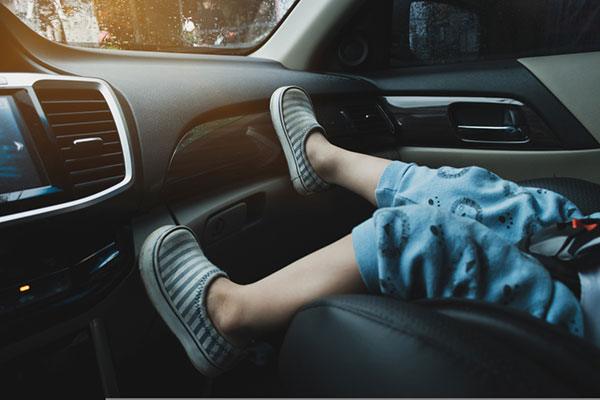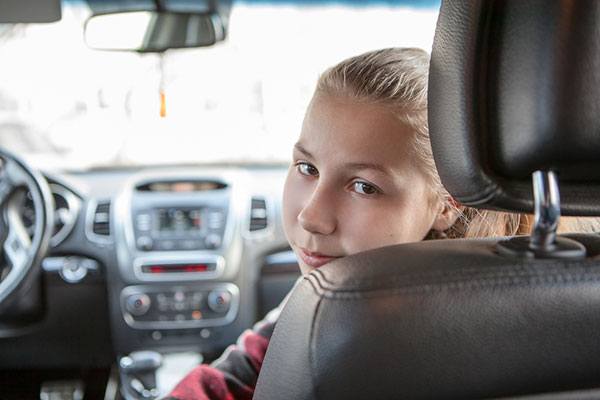When can kids sit in the front seat? A direct question for all experts, safety technicians, and manufacturers. However, is there a straightforward answer?
Although the American Academy of Pediatrics states that children younger than thirteen should NOT ride in the front seat, there are always special circumstances.
If your kid is smaller for their age, they should be adequately restrained in the back seat.
So, below you can find all you need to know about children riding in the front and all car seat safety tips and tricks by their age tag.
More...
What Are the Dangers if the Young Children Sit in the Front Passenger Seat?

Generally, car manufacturers create cars with an active airbag system to protect adults who are at least five feet tall and weigh approximately 150 pounds.
So, if your child sits in front, they will have to suffer from a serious injury created by the passenger airbag.
Thus, when your young child rides next to you, the force of the air bag system can break them.
In addition, the air bag system can cause severe head injuries since the passenger air bag will lift them off the seat to hit the car's top.
Therefore, once your child overgrows maximum weight and height limits in the rear-facing car seat, forward-facing car seat, or even the belt-positioning booster seat, the safest place is the back seat.
They need to sit in the middle seating position of the back seat, as long as there is a seat belt system (lap and shoulder belt) to use.
However, when your child is already thirteen and wants to ride next to you, you should also take safety steps to prevent the possible risk of injuries. Thus, you can:
1. Always demand that your child wears the seat belt system
2. Ensure the child wears the seat belt properly with their back against the frontal seat to further away from the dashboard.
Remember: the shoulder belt should cover the chest, not the neck. Also, the lap belt should cover the upper thighs, not the stomach.
3. Move the vehicle seat back to avoid the impact and force of the air bags. As most collisions affect the front part of the motor vehicle, the seat won't be too much involved in the back.
Bear in mind that even if you have a thirteen-year-old child, if they weigh more than 150 pounds but are smaller - more precisely four feet nine inches tall, they must use a booster seat with all necessary lap and shoulder belts to fit their needs correctly.
Various states have different car seat laws on when kids can sit and ride properly next to their parents.
So, if you don't obey the law, you will have to pay fines.
What Are the Car Seat Laws Regarding When Kids Can Ride in the Front Seat?

When can kids ride in the front seat?
Such laws include California law, Georgia car seat law, Hawaii, New Jersey car seat law, Rhode Island law, and Tennessee car seat law.
According to these authorities, all children under eight must be in the rear seat, installed correctly, meeting their development.
However, there are other car seat laws regarding the proper age when children can ride next to you, including:
- Delaware - this car seat law doesn't allow children to sit and ride next to parents until they're twelve years old and 65 inches tall.
- Maine - the official law states that children cannot sit next to you until they're twelve and weigh 100 pounds.
- Puerto Rico - according to their car seat law, children must remain in the back seat until they're twelve.
- Washington - the children need to be seated in the back seat of the vehicle only when they're thirteen years old.
But, all US car seat laws and child passenger safety regulations you can find HERE.
Why Is It Crucial to Follow All Child Passenger Safety Rules?
Let's face it - all of us used to sit in the front seat, next to the drivers, when we were younger.
However, the times change, and of course, today, we do have an increased number of accidents, which, in many cases, end up fatally.
The main reasons are no respect for speed limits and inappropriate safety procedures.
Bear in mind that a significant number of parents use car seats that are not correctly installed, so in car crashes, their kids either get hurt or die.
So, it's crucial to stick to the child safety seats and proper child passenger safety restraint systems for their development.
Main reasons to stick to the child restraint systems:
1. Development
Although kids may reach the height limit, their skeletal system is still developing; therefore, their bones are not strong enough.
So, as the Paediatrics Child Health states, kids under twelve and younger may suffer from seat belt syndrome, as the lap belts may not fit properly and cover the abdomen instead of thighs.
So, they need to sit in the back seat until they're thirteen, with all bones developed.
2. Safe Place
The back seat is the safest place of all when riding your kids. The seat belts will keep them stable and secure, without any issues.
Also, the collision will affect only the frontal vehicle part, so your little ones will remain intact at the back.
So, the back seat reduces the external force, strength, and pressure, keeping your child safe.
3. Air Bags Fit Adults (Men) of 140 Pounds Wearing a Seat Belt
Many studies show that women of this weight cannot endure the pressure and force of the air bags in frontal crashes.
Therefore, the airbag systems are not intended for children, lighter and smaller in size. They could cause severe injuries to their face, necks, chests, and heads at speeds between 90 and 210 mph.
So, if you take a look at data over the years, more than 100 children died due to air bags. But in slow-speed conditions, the rate should be minimal.
So, older kids are developed enough to use their seat belts and able to endure the force of the airbags if there is a car accident.
What Are the Fundamental Child Restraint System Rules?

Using an appropriate and properly installed child restraint system and applying safety belt straps is vital for keeping your kiddo safe in the car.
It would be best if you never placed a rear-facing car seat with the active airbags.
However, if the rear seat cannot be placed in the back, you have to turn the airbag system off to reduce the risks of injuries.
Below you can see the basic rules regarding child car seats:
1. Birth to Two
All children between birth and the age of two must use rear-facing car seats.
It would be best to continue with the rear-facing seats until they reach the upper limit of 40 pounds. Some parents use rear seats as long as possible, according to the instructions.
Rear seats have car seat cushions that support the child's neck and spinal cord.
But, if you first use an infant carrier, change to a convertible car seat, but use it rear-facing and installed properly.
2. Ages Two to Eight (or Older)
Once they overgrow the rear-facing seat, the children must use the forward-facing seat. They should remain inside until they reach the maximum size and weight limits.
Often, the weight limit is between 40 and 65 pounds, but you can check the manufacturer's instructions if you're not secure.
3. Ages Eight to Twelve
Once the kids overgrow the forward-facing car seats, it's time to use belt-positioning booster seats. Thus, the kids will sit at the safest angles and height to prevent injuries in car collisions.
Children will stay in the booster seat until they're four feet nine inches tall.
The booster seat ensures the child sits properly, restrained with the lap belt and shoulder belt over their most vital parts, to prevent high risks in crashes.
4. Children Older Than Thirteen Years
Once they exceed the weight limits of the booster seat, the teenagers can sit in the front seat, but they must wear a seat belt.
Again, you must ensure the shoulder strap crosses the chest, not the neck, and the lap strap covers the upper thighs, not the stomach.
FAQs
How much do you have to weigh to sit in the front seat in NY?
According to the New York State Department of Health, in NY, the kids can be in the front once they're thirteen years old, weighing between 75 and 145 pounds for boys and 76-148 pounds for girls.
At what age can you sit in the front seat in CT?

According to the Connecticut car seat law, the child can ride in the front once they are eight years old, weighing more than 60 pounds.
First, however, they must wear the appropriate seat belt system.
How many pounds do you have to be to sit in the front seat in California?
According to the California Highway Patrol, all children older than eight and taller than four feet nine inches can sit next to the driver.
Therefore, California law states that all children must weigh more than 57 pounds.
Do you turn the airbag off if a child is in the front?
Yes, you do when you use rear-facing seats. However, you can turn them on when using a forward-facing seat for older children.
What happens to the car seat in the accident?
If you have car accidents and your child's car seat is affected, you need to replace it immediately!
The car seat will be unsafe for further use, so please, get a new rear seat, a convertible car seat, or booster seat for your little ones.
Summary
So, when can child sit in front seat?
Well, as you can see, the rules and laws vary from state to state, but the AAP states that the minimum age must be thirteen. So, many regulations respect this.
My advice is to follow the law and make your child stay seated in the appropriate car seat to avoid accidents, injuries, and fines.
Also, visit the NHTSA site to find more info about car seat inspections and CPSTs near you.

Keep sharing good content.
wish my fam used these rules